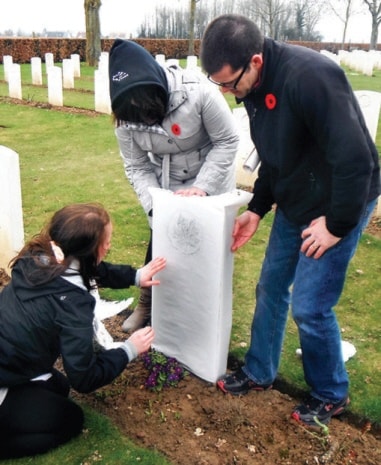One Ponoka teacher has found a way to make the study of past world wars personal, which creates a better understanding of what soldiers went through. Part of the learning involves a tour of European war memorials.
The Broncs World Tour takes Ponoka Composite High School (PCHS) students across the Netherlands, Belgium, France and Spain to document the story of Ponoka soldiers who were killed in action. They visited war cemeteries from both world wars to receive a better understanding of the sacrifices Canadian soldiers made.
The tour was designed by social studies teacher Ron Labrie to commemorate fallen soldiers. He used the names from the Ponoka Legion cenotaph in his research and has travelled to Europe with PCHS students every year in a credited course.
“All of those things give a person some scope,” explained Labrie.
Being able to experience the memorials firsthand gave Grade 12 student Shania Kjenner an understanding that history books are not able to provide. “I’ve been there, I’ve walked there.”
Researching the stories of these fallen soldiers also helped develop a personal connection for some students. Sam Quinn feels one of the best parts of the project was taking the time to find out more about a person. “They’re a complete stranger to you but you get to know them.”
The Canadian soldiers are well respected at these memorial sites, which could be seen by how well the cemeteries were taken care of. The grass is well kept and the gravestones are maintained.
“There’s a lot of reverence and respect shown,” explained Labrie.
One story involves a Ponoka soldier who died in a plane crash with six other men; their remains were buried behind a church. Each gravestone had one flower pot in deference to the soldiers but only one, Robert J. Riddoch, had a flower blooming.
“The only one blooming with a daffodil plant was our guy,” said Karen (Captain) Kirk.
Students also visited the port town of Dieppe, France where Canadian soldiers lost their lives during the Dieppe Raid in August 1942. More than 60 per cent of forces perished in the assault and many planes were lost in the raid.
Rather than a sandy shore, Dieppe’s beach is covered with large rocks and is surrounded by high cliffs, which make natural defenses.
“We got a sense of how it was,” said Labrie.
For Jamie Anderson-Miller however, Vimy Ridge was the most memorable. The First World War memorial is located in Vimy, France and immortalizes the efforts of Canadian forces to take over the area from the Germans in April 1917. The effort worked and Vimy Ridge remembers the efforts of those soldiers who died in the attack.
“Feel like Vimy Ridge was the most symbolic to me,” said Anderson-Miller. “No textbook or picture gives it justice.”
Students gained a strong sense of pride for Canadian troops during the tour and found an interesting comparison to American memorials. Trevor Malterer suggests the difference is in the presentation as American cemeteries appeared to glorify soldiers’ efforts. “It was very much based on the (American) victory and death.”
Canadian sites appeared to focus on the effects of war and how it affects people’s lives.
“It was very much based on human impact,” added Malterer.
The tour took students to the House of Anne Frank in Amsterdam and then to the south of Holland to Bergen-op-zoom. They travelled to Flanders Field in Ypres, Belgium and took part in the Menin Gate Memorial, which occurs every night at 8 p.m. Students laid wreaths, which were donated by the Ponoka Legion and Labrie was interviewed by a local television station.
Then students travelled to a German cemetery and then to Lilles, in the north of France. After that a tour of Vimy Ridge and Bois-Héroult was next. Students learned about the French resistance and its efforts during the Second World War and also visited the Normandy beaches including Dieppe and Omaha Beach.
They concluded the trip in Paris, France and in Barcelona, Spain to take in the culture and architecture.
During visits to the gravesites students took rubbings of soldiers’ headstones to bring back to Ponoka and then use in their school projects. Shania Kjenner summed up her feelings of the tour. “I would go back in a heartbeat.”
This trip has become nationally recognized and Labrie receives correspondence from people in Europe who are interested in students’ findings. The 12-day trip started May 19 and concluded May 30.
Research roadblock
Social studies teacher Ron Labrie has reached a roadblock in his research for the cenotaph project and is seeking the assistance from residents. Labrie can find no information on these veterans and he would like to know their fates:
• From the First World War: F. Ames, G. Armstrong, S. Bascombe, Clifford H. Clayton, Francis Clayton, O. Davis, W. Grant, Jack Jones, W. Jones, W. Murray, J. Murray, L. Morrow and Jim Pike.
• From the Second World War: Kenneth Lucas and Ernie Meyers.
